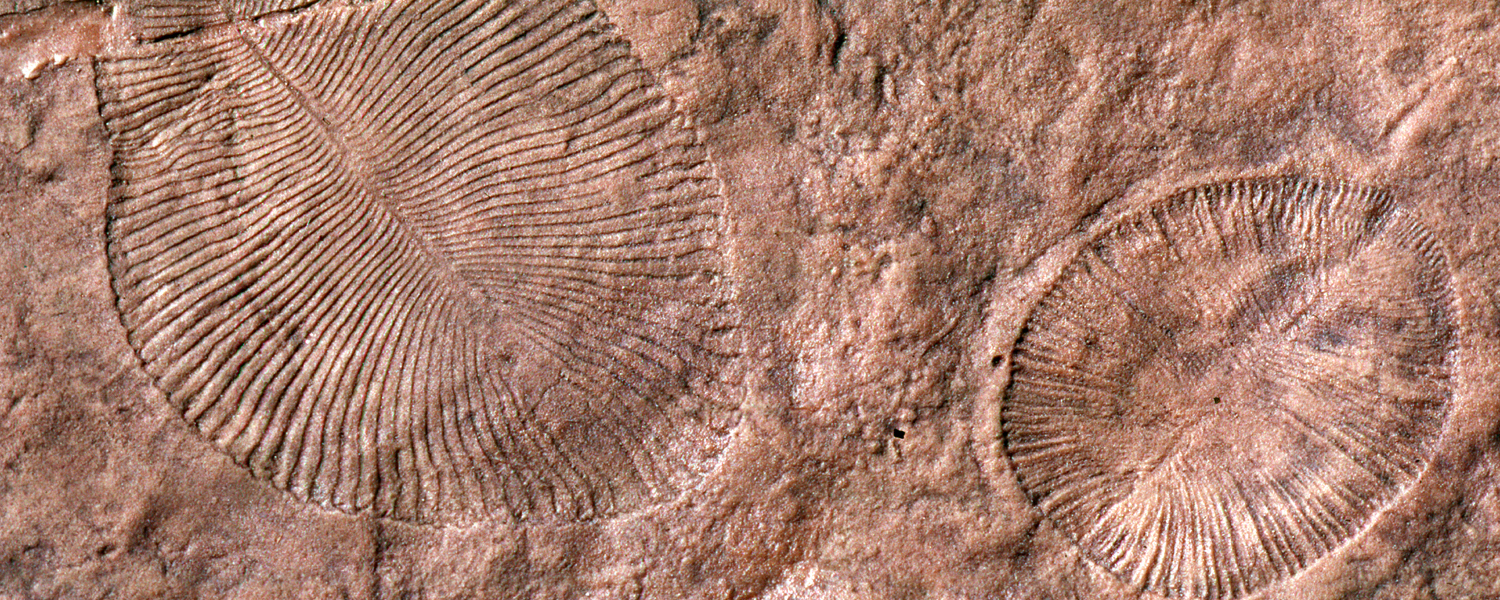

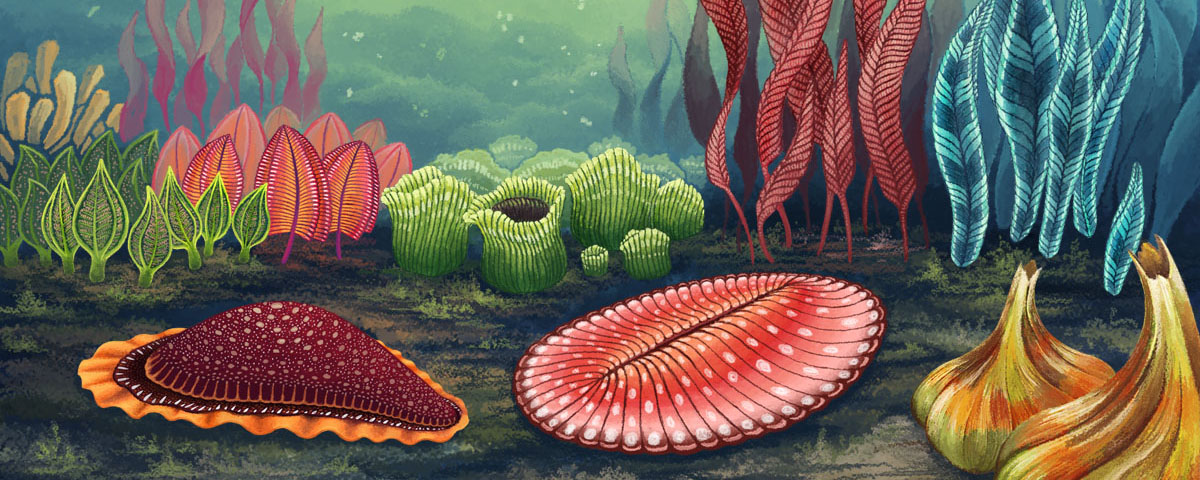
"First impressions are always unreliable" -- Franz Kafka
BIG QUESTION: What do the Ediacaran fossils represent?
Background: What is the Cambrian? What is the Cambrian Explosion?
The Cambrian Period (541-486 Ma) is the first period of the Phanerozoic. It was traditionally recognized by the
oldest known specimens of fossils with skeletons (of silica, calcium phosphate, or [most commonly] calcium carbonate)
that can be seen by the naked eye. More intriguingly, instead of just one species ancestral to all other skeletonized
forms, many diverse clades
simultaneously show up in the record. This was a useful biostratigraphic marker, but a puzzle to evolutionary
biologists.
That is not to say that there were no known Precambrian fossils; just no fossils of macroscopic organisms. One false start was "Eozoon" (which turned out to be a metamorphic rock). However there are similar-looking structures common in the Precambrian (and Cambrian) called stromatolites. These layered structures are the byproducts of biofilms (aka "slime") created by prokaryotes, catching particles of sediment and producing mounds in tidal zones and similar environments. Modern stromatolites only form where the water is too harsh (normally to saline) for animal life, but earlier they formed in a wider variety of environments.
The position for the base of the Cambrian--the stratigraphic marker to be used--was debated during the middle of the 20th Century. It had been recognized that below the Cambrian Explosion proper (first trilobites, first big mollusks, etc.) there were other skeletonized fossils: archaeocyathid sponges and an assortment of tiny calcareous fossils of various shapes nicknamed the "Small Shelly Fossils" (or "Small Shelly Fauna", or "SSF"). And below those there are the first trace fossils that dip down into the sediment and back out again: Treptichnus pedum (once called "Phycodes pedum"). Recent work strongly suggests that Treptichnus pedum was generated by priapulid worms (known to have been fairly common in the Cambrian). If priapulids were present by the time T. pedum, then the diversification among metazoans was well underway by that point and we have to look for the origin of animals in the Proterozoic Eon.
In 1992 it was proposed (and ratified in 1994) to use a location near Fortune, Newfoundland, Canada as the site for the formal base of the Cambrian. The horizon picked was one that was (at the time they ratified this) the lowest occurrence of Treptichnus pedum at that location. Under this model, the SSF appear after this, as do the first archaeocyathids, and then the great diversification that is the Cambrian Explosion.
The most primitive types of animals. They are suspension feeders in which water comes in through pores on the inside to be picked up by flagellated cells on the inside; essentially living sacs. Shape of sac is held together by spicules that might be siliceous, calcareous, or made of the protein sponging. Recent work has shown that sponges may not be a monophyletic group: some may be more closely related to eumetazoans (advanced animals) than they are to the other sponge groups (in which case "Porifera" is a paraphyletic group).
The remaining animals (i.e., non-sponge animals) are the Eumetazoa, or "true animals." They share the following specializations:
Most eumetazoans are bilaterians. But the two basal branches (Ctenophora ("comb jellies") and Cnidaria) have radial symmetry: a top and a bottom, but no front/back or right/left. Both groups are very soft bodies (i.e., they are jellies), but at least some cnidarians (the corals) have a good fossil record. The relationships between the ctenophores, cnidarians, and bilaterians remains unresolved.
In ctenophores and cnidarians there is a gut with a single opening, fringed by sticky (ctenophore) or stinging (cnidarian) tentacles. These tend to be suspension feeders or passive predators. Ctenophores are free-floating, but life of cnidarians can vary much more: some live entire life attached to surface as a polyp; others float around with tentacles underneath them as medusa; some alternate between polyp and medusa. Ctenophores and cndarians are soft bodied, so typically are only preserved by impressions or in carbonization. However, the corals produce calcareous skeletons, and so have an excellent fossil record.
The majority of advanced animals are in the clade Bilateria. Bilaterians ("worms" in the broadest sense): animals with a front end, a back end, a left-to-right symmetry, and a top-to-bottom symmetry. Additionally, bilaterians typically have a mouth at one end, a gut running through the body, and an anus at the other end.
There are a great number of worm-shaped bilateral taxa (nematodes, nematomorphs, annelids, etc.) with no significant fossil record. (One group, the priapulids, show up in many Cambrian sites, and were probably a major group of early predators.) But the vast majority of bilaterians take the basic "worm" body plan and modify it into something very different. As it turns out, nearly all the good fossilizers are such non-wormy "worms."
Below is a simplified cladogram of the Metazoa:
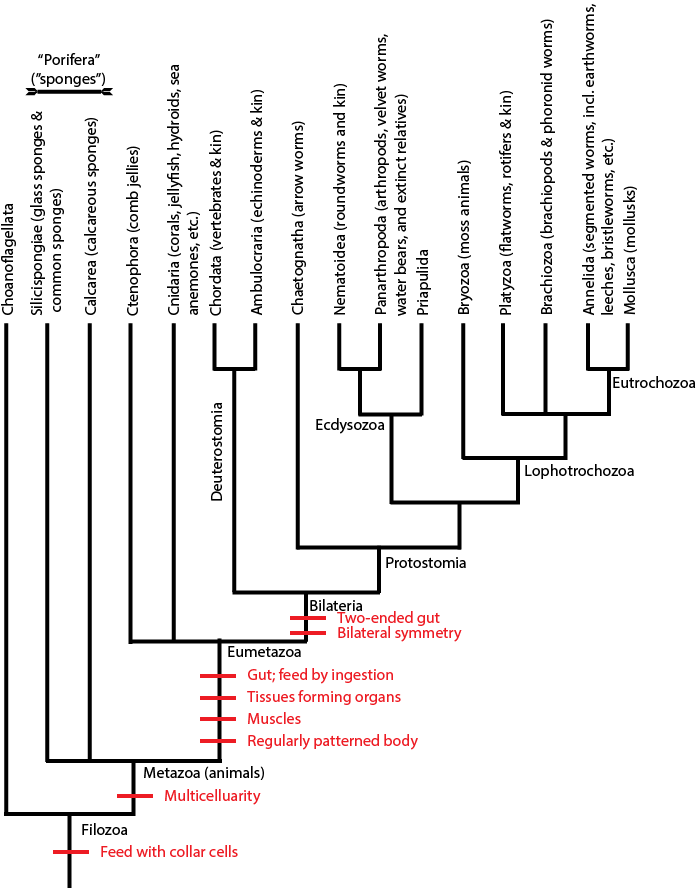
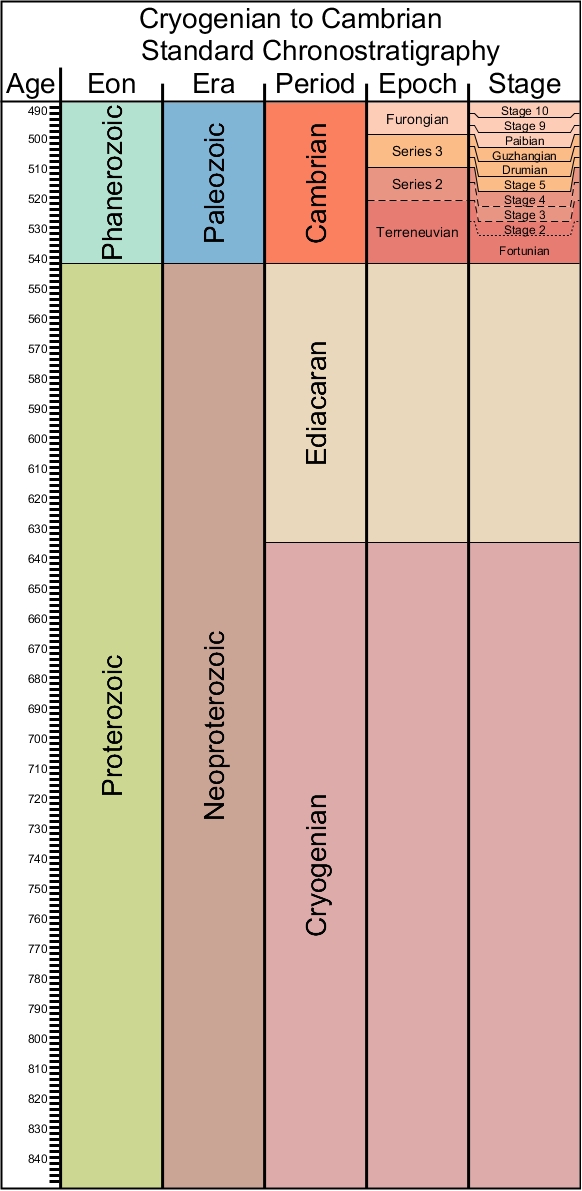
What is the evidence for multicellular organisms in the Proterozoic Eon? Macroscopic colonies of organisms (possibly prokaryotes, more probably eukaryotes, called Grypania) are known from 1.87 Ga (previously dated to 2.1 Ga). Likely multicellular red algae (Bangiomorpha) are present by 1.047 Ga (previously dated as old as 1.6 Ga). Complex communities of multicellular algae are present by the Ediacaran. But what about metazoans?
We should consider the following questions when addressing issues of putative Proterozoic animal fossils:
Recall that "sponges" (the paraphyletic grade comprised of Silicea and Calcarea) are the basal branches of metazoans. One would expect that they would be the first to show up in the fossil record, as in fact they do:
How about other groups? One intriguing bit of evidence from the 1800 Ma (1.8 Ga) Stirling Range Formation: trace fossils that seem to indicate a macroscopic animal moving along the surface of the sediment, pushing it out of its way. This led to great debates about the age of the Stirling Range Formation, but it does indeed seem to be quite old. However, discovery that the macroscopic multinucleate amoeba Gromia leaves trails as it very slowly moves around which look just like the Stirling Range Formation tracks undermines these ichnofossils as evidence of early worms.
Another intriguing line of evidence that was of great interest over the last 20 years are the Doushantuo "embryo" fossils. This formation (which runs from the base of the Ediacaran at 635 Ma to about 551 Ma at the top: the fossil-bearing layers are concentrated from 600-590 Ma) preserves many microfossils and small macrofossils (including algae, sponges, tubular fossils, and so forth), primarily by a phosphatized coating. Some of the fossils resembled the dividing cells of cnidarian and bilaterian embryos, although neither late-stage embryos nor adult organisms ever showed up. Although some still consider these embryos to be evidence of metazoans, an alternative hypothesis strongly suggests these are actually the dividing stages of unicellular organisms. Whether these belong to the stem-lineage leading to animals, to choanoflagellates, to fungi, to plans, or to any other of the diverse groups of eukaryotes has yet to be established. So like the Stirling Range Formation ichnofossils, the Doushantuo embryos might well be produced by something that aren't animals.
The Ediacaran Biota: The actual evidence of Proterozoic animals (even macroscopic animals) was actually first discovered some time ago. In 1872 fossil impressions given the name Aspidella terranovica were described from St. Johns, Newfoundland, Canada. These simple sets of concentric rings were not particularly convincing as animal fossils to people at the time (instead, they were quite reasonably dismissed as some kind of abiogenic sedimentary structure), but in hindsight were eventually realized to be the first described Neoproterozoic metazoans.
In 1957 a young kid walking in Charnwood Forest, UK discovered a leaf-like fossil in the Precambrian rocks present there. This discovery became recognized as Charnia. Because the geology of the UK was so well-studied, it was definite that these were from below the Cambrian, and the news went worldwide of the discovery of macroscopic Precambrian animals.
As it turns out, however, even better fossils of a diverse community of organisms had been discovered and published back a decade earlier. In 1946 Australian mining geologist R.C. Sprigg was exploring the Ediacaran Hills of Flinders Ranges, in Australia. These only reached international attention, however, in 1961, which is why the Charnwood fossils are generally regarded as the "first discovered" Precambrian animals. The great diversity of forms found at Ediacara led to all fossils of this variety being lumped under the name "Ediacara Biota". Such fossils have been found in many locations around the world (other than those already mentioned, they include the White River localities in Russia and the Nama locality in Namibia).
Preservation of the Ediacaran Biota: The Ediacaran organisms are macroscopic: some up to a meter long or so, but most much smaller. They are primarily preserved as impressions in sediments (sometimes shallow-water coarse sandstones, sometimes deeper water shale). (In some cases the outside skin surface is preserved by permineralization or replacement.)
Phylogenetic Affinities of the Ediacaran Biota: From the 1960s until the 1980s (and by some researchers even into the 21st Century), these fossils were interpreted as early representatives of well-known Phanerozoic groups like cnidarians, flatworms, segmented worms, arthropods, etc. However, paleontologist Dolf Seilacher and his colleagues pointed out the following aspects about that many of the fossils of the Ediacaran Biota do not match our expectations for members of any of the living groups of animals (or at least eumetazoans):
Not all Ediacaran Biota organisms fit the above profile. We will deal with the Ediacaran stem-mollusk Kimberella later. There are some Ediacarans that do match some Phanerozoic groups of non-bilaterian animals:
But what about the rest of the Ediacaran critters? Seilacher argued that these organisms formed their own clade (Vendozoa or Vendobionta) separate from Metazoa. However, the patterning of these bodies are more like animal growth than most other multicellular animals: indeed, having a "front" and "back" throughout development in some forms suggests at least some HOX genes were present. Recent work by S. Xiao and M. Laflamme suggests that different Ediacaran forms represent different stem-group parts of the metazoan tree. (In fact, under this model, the ancestors of the bilaterians would have passed through an "Ediacaran biota" phase.)
Kimberella: One of the Ediacaran organisms stands out as being neither a cnidarian nor a "vendobiont"- type animal, but a probably crown-group bilaterian. This is Kimberella (commonly preserved as a belly print, but occasionally preserved showing the top surface). It is often associated with scrape marks suggesting a radula scraping up algae from the algal mat. Based on the preserved data, Kimberella appears to be a stem-mollusk, sharing some but not all traits common to the concestor of living Mollusca. In particular, it appears to have:
If Kimberella is indeed a stem-mollusk, then by minimum divergence time it requires that stem-annelids, stem-platyzoans, stem-brachiozoans, stem-bryozoans, stem-chaetognaths, and stem-deuterostomes must also be present in the Ediacaran. And thus, the major divergences among Bilateria occurred long before the Cambrian Explosion.
Paleoecology of the Ediacaran Biota: How did the Ediacaran biota make a living? Some are easy to figure out: Kimberella seems to have been an algae-scraper (the ancestral condition for Mollusca), and sand corals and sponges as suspension feeders. But what of the other forms?
The Ediacaran was still part of the Time of the Slime: algal and bacterial mats covered much of the surface of the sea floor. This matground provided both a habitat and food source for a number of niches in the Ediacaran community. There are some (often larger) Ediacaran forms that seem to have sat on the mat, moved slightly, sat again, moved again, and so forth. It appears that the mats underneath each of these was digested (although some argue it simply died by being cut off from sunlight & nutrients). This suggests that at least some of these were osmotrophs: feeding by absorbing nutrients over the body surface rather than ingesting into a gut or similarly engulfing food particles.
If osmotrophs were present in many of these Ediacaran forms, this could explain the lack of mouths, guts, anus, etc., in these impressions: they may not have been a digestive tract at all. Osmotrophy is different from the feeding in sponges but also in eumetazoans. (There is a very poorly known group of tiny animals today, the Placozoa, which feed by osmotrophy.)
So the paleoecology of the Ediacaran community consisted of a number of forms:
Predation seems to be absent or at least very, very rare, so some refer to this time as the "Garden of Ediacara" (in analogy to the Paradise of the Garden of Eden).
Ediacaran Calcifiers: While the vast majority of fossils of the Ediacaran are soft-bodied, there are a few very small organisms with hard parts. Coronacollina (mentioned above) seems to have had siliceous spicules, but these are not preserved. There are a few calcifying organisms as well. The first discovered of these was Cloudina: small cone-in-cone calcitic tubes, most likely formed by some kind of eumetazoan. These are VERY tiny, and so it isn't a surprise they were missed for so long.
The other major calcifier is Namacalathus, tiny spheroids with holes on the side, set atop a small stalk. These seem to be some form of suspension feeder: indeed, they are quite likely some form of calcifying sponge. Larger than Cloudina, they are nonetheless very, very, very small. (Another calcifying organism-- Namapoikia--seems to be an encruster, but is not clearly a metazoan: it could be a unicellular form.)
Recent (March 2017) discoveries finds that the calcifiers (including some new discoveries) are only found in carbonate rock, and that they all have nearly-identical soft-tissue versions in detrital sedimentary deposits. It appears that the same organisms produce unshelled structures where carbonate minerals are not abundant, but can calcify when limey mud (and carbonate rich water) is around.
Let's revisit the phylogeny of Metazoa, and see where they Ediacaran forms might fit:
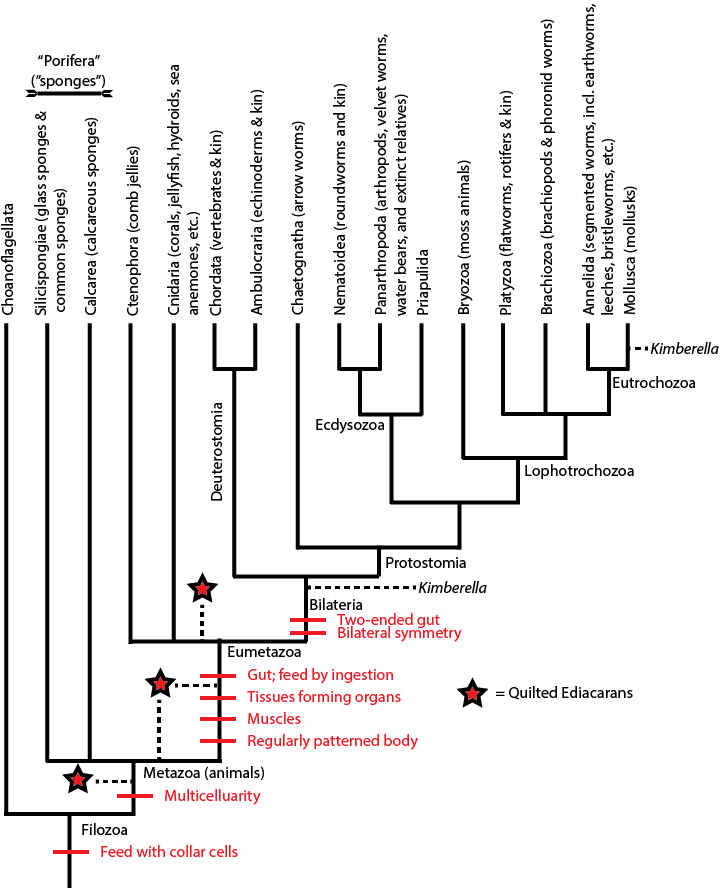
Kimberella might be a stem-member of Mollusca, or a stem-bilaterian, or many positions in between. The typical quilted Ediacaran forms seem to be multicelluar. Some might be stem-metazoans. Since many of them show regularly patterned bodies, and at least some show signs of movement (and thus muscles), but none show guts, they might be stem-eumetazoans. (An alternative is that they are crown-eumetazoans that lost their guts).
Proterozoic Oceans and Increasing Oxygen Levels: The oceans of the Neoproterozoic seem to have been considerably different than the oceans of the Phanerozoic. Modern oceans are largely clear, well mixed (with lots of oxygen distributed through out), and contain complex food webs of animals, algae, phytoplankton, and so forth. In contrast, Neoproterozoic oceans seem to have been cloudy with bacteria and organic matter, very stratified (layered with not much mixing) with a lot of anoxic levels, and very simplified ecosystems.
Chemical evidence in the sedimentary record shows that the Neoproterozoic was a time of increasing oxygen levels. This may have been the spark leading to the multicellular algae and metazoans: large, complex eukaryotes require a lot of oxygen to operate. It may be that there is a positive feedback loop involved: increasing oxygen favors diversification of animals (some of which are suspension feeders) --> cleaner water --> success of eukaryote algae --> more oxygen produced than by cyanobacteria --> increased size and diversification of animals --> and so on.
Serpents in the Garden: At the very very end of the Ediacaran, new types of trace fossils show up. The first burrows descending somewhat into the sediment are present. These include Treptichnus and a few other similar forms, and are consistent with tunnels dug by priapulid worms. Priapulids are known to be predators, and so we have a spreading of carnivores at the end of this interval. Given how vulnerable most of the Ediacaran forms seem to have been to predation, this may have been the death knell of the Ediacaran biota. (In fact, given that the Ediacaran biota forms are not present in the Cambrian (one suggested Ediacaran-style frond in the Cambrian turns out to be a cnidarian with mouths), this may have been the first mass extinction for Metazoa.)
If these are priapulids, that means stem-priapulids are present before the start of the Cambrian, which requires stem-members of the Panarthropoda-Nematoidea clade being present.
So here we are at the base of the Cambrian:
But where is everything else?? We get to the base of the Cambrian, and still haven't solved the problem of the Cambrian Explosion! That will be the next topic we get to.
A Brief History of Geologic Time:
The Search for the Earliest Life:
The Great Oxidation Event, the rise of green chlorophyll:
The "Green Holocaust", when oxygen from photosynthesis almost killed everything:
How Two Microbes Changed History (Endosymbiosis and the rise of the Eukaryotes):
